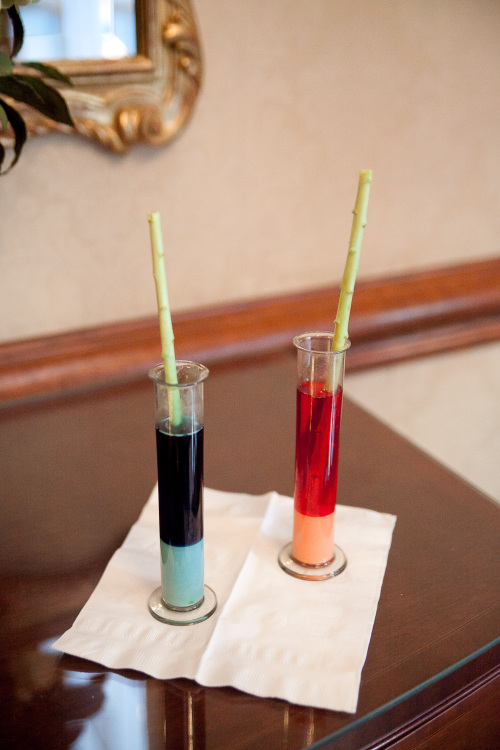
I wish to propose a hypothesis: A 5th grade science activity can make a meaningful and exciting unity ceremony.
That's what we did for our unity ceremony — we opted to do something more like a unity experiment or unity reaction. When I proposed this idea it was met with lots of “Are you sure?” and “I don't know…”
Our officiant loved the idea, but didn't really understand what we were trying to convey, or even the science behind it. He requested that I send an explanation, so I did. Much more to my surprise he liked it so much he read it as the explanation of the ceremony at our wedding.
Here's how we explained it:
To better explain our unity ceremony of science: A chemical reaction results in an entirely new compound from two or more separate ones. They are unique on their own, but brought together they form something new.Rather than flat out calling it the baking-soda vinegar reaction, we'll call it Sodium Bicarbonate and Acetic Acid (for science). When brought together the individual molecules break apart and form three different substances — Carbon Dioxide which form bubbles, which escape from the mixture and go into the air. Sodium acetate which is widely used, but also acts as a buffer in other solutions meaning the remaining solution will not easily become too acidic or too basic. It will remain at a fairly constant pH even when acids or bases are added. The last component it produces is water, the molecule of life. I could prattle on about other cool stuff water does, but it would probably bore everyone.
Related PostBreak the glass in a whole new way with a Prince Rupert's Drop
Val and Galen's science tendencies led them to a really interesting and symbolic unity ceremony. They created what's called a Prince Rupert's Drop. I'm sure... Read more
Regardless of whatever we try to do we can never again separate the baking soda and vinegar because they are no longer in the beaker, they have come together never to be separate again.
Another approach I considered was to speak about how molecules interact with each other. Two molecules can come into contact and have no reaction. Other molecules can react very violently with each other, while the right set can create incredible things together. What is that phrase people use when two people get on really well together? Oh yes! Chemistry!
Now here's the fun part:


Our ceremony used three graduated cylinders, two small (100-200ml), one large (1000ml).

To help with the visual aspect we added food color to the two baking soda solutions so when they mixed together they formed a different color when they were done.

We opted for 2/3 white vinegar and water solution in the large beaker (around 200-300 ml) and two half baking soda and water solutions in the smaller beakers. This created a nice overflowing bubbling rather than an explosive spray out of the top of the beaker. Some people might want a big explosion. (FYI: Some experimenting is in order before you do it live.)

Here is me feeling delighted about the whole thing. Once the CO2 stops bubbling its way out the resulting color was purple.
The unity reaction was met with mostly positive results. Guests enjoyed it, and those who didn't have stayed politely quiet about it. People seemed to enjoy the ninja science lesson with the ceremony, and felt the explanation helped give it meaning rather than being dramatic or contrary for the sake of being different. Do what feels right for you and your partner. Guests are remarkably ok with something out of the ordinary.
photography: J. Scott Photography






